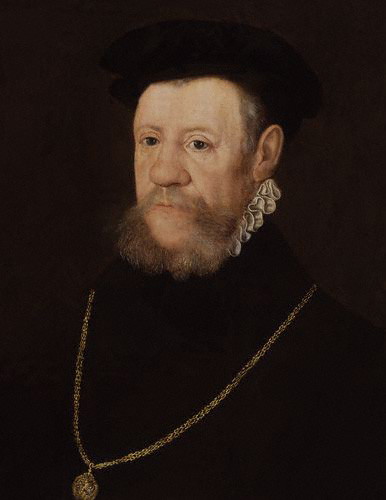 On 27th or 28th September 1553 (sources differ regarding the date), Mary I travelled in a decorated barge to the Tower of London to prepare for her coronation. She was accompanied by her half-sister, Elizabeth, and as they pulled up to Tower Wharf, they were greeted by music and cannons firing. It was traditional for monarchs to go to the Tower before their coronations and process from there to Westminster.
On 27th or 28th September 1553 (sources differ regarding the date), Mary I travelled in a decorated barge to the Tower of London to prepare for her coronation. She was accompanied by her half-sister, Elizabeth, and as they pulled up to Tower Wharf, they were greeted by music and cannons firing. It was traditional for monarchs to go to the Tower before their coronations and process from there to Westminster.
Here are some primary source accounts of this day in history:
"The xxviij day of September the Qwen('s) grace removed from Sant James, and so to Whyt Hall, and ther her grace took her barge unto the Towre, and ther all the craftes and the mare and the aldermen in bargurs (fn. 42) with stremars and mynstrells, as trum pets, wettes [waits], shames, and regalls, and with a gret [shooting] of gunes tyll her grace cam in-to the Towr, and...[the rest is missing]" The Diary of Henry Machyn Citizen and Merchant-Taylor of London (1550-1563)
"Note, that the xxvij. of September, the quenes majestye cam to the Tower by water towarde hir coronatione, and with hir the lady Elizabeth hir sister, with diverse other ladyes of name, and the hole counsayll. The lord Paiget bare the sworde before hir that daye. Before hir aryvall was shott of a peale of gonnes." The chronicle of Queen Jane, and of two years of Queen Mary, and especially of the rebellion of Sir Thomas Wyat
"The 27 of September the Queene removed from St. James and The Queen removinge tooke her barge at Whitehall in the afternoone aboute iii of the clock, so to passe to the Tower of London, shootinge the bridge at a full sea." A Chronicle of England During the Reigns of the Tudors, from A.D. 1485 to 1559, Volume 2.
"The 27 of September, Q. Mary came to the tower by water, accompanied with the Lady Elizabeth her sister, and other ladies, before whose arrivall was shot a great peale of guns." Annals of England to 1603.
Members can check out more primary sources for Mary I and her reign on our Mary I Primary Sources page.
Notes and Sources
- 'Diary: 1553 (Jul - Dec)', in The Diary of Henry Machyn Citizen and Merchant-Taylor of London (1550-1563), ed. J G Nichols (London, 1848), pp. 34-50 http://www.british-history.ac.uk/camden-record-soc/vol42/pp34-50.
- The chronicle of Queen Jane, and of two years of Queen Mary, and especially of the rebellion of Sir Thomas Wyat by a Resident in the Tower of London, ed. John Gough Nichols, Camden Society, 1850. Read at https://archive.org/stream/chronicleofqueen00nichuoft#page/26/mode/2up
- A Chronicle of England During the Reigns of the Tudors, from A.D. 1485 to 1559, Volume 2, Charles Wriothesley, read at https://archive.org/stream/achronicleengla01hamigoog#page/n109/mode/2up
- Annals of England to 1603, John Stow, read at https://archive.org/stream/annalsofenglandt00stow#page/n1065/mode/2up



That would be Mary’s usurpation.
No Mary Tudor was legally next in line. It was Jane Grey Dudley and family who were put on the throne illegally by Edward and his Device for the Succession. I am certain that there is a link to an article on this somewhere in the list of many on the site, but there is also the triple biography by Learne de Lisle on the sisters which I recommend. Edward tried to cut out both of his sisters, Elizabeth and Mary, but I doubt many would say Elizabeth was not a rightful Tudor Queen, even though almost every power in Europe had severe holdups on her. Mary and Elizabeth were excluded because of Edward’s view that they were both illegitimate, but Mary also because of her Catholic faith. Although he did not want a female to rule, just as his father had done, the only valid candidates for the throne were all female. The Device is an extraordinary document in the young King’s own hand, which shows several changes as he originally saw Jane as having male children. Edward forced her mother Frances who was next after Mary and Elizabeth to give up her right as it was unlikely that as she was in her late 30s that she would have a son soon. The 16 years old Jane was a much better prospect in his eyes but Edward was dying and realized that he could not wait. He changed the Device to read…The Lady Jane and her heirs male. Mary Tudor acted fast, gained rapid and popular support, the council were written to and abandoned Jane who had moved to the royal apartments in the Tower of London for her coronation. Mary was celebrated all the way to the Capital and proclaimed to cheering crowds. She was a Tudor and the people knew her. Who was Jane Dudley was the question that everyone asked when she was proclaimed to stoney silence. Now it is argued that Jane should be in the list of Queens as she signed military orders Jane the Quene, but it is a debate that is far from settled. Jane may not have wanted the crown but she used its power, she was still not the next in line and, according to legend said so, although other sources dismiss this protest. Jane was not the next in line, Mary was and it was she who was replacing a usurpation, not the other way around.
I did a talk on whether Jane should be called “Queen Jane” and whether she was legally put on the throne – see https://www.tudorsociety.com/queen-jane-lady-jane-grey/
Thanks Claire.
Excellent talk, Claire on the legislation and legal system which supported Edward vi and his decision to set Jane as his legal successor. I am sure Henry Viii thought that he had all the bases covered when he made his will, but he also left the backdoor open for change and with this, trouble by not repealing old legislation. Not all laws were repealed when knew ones replaced them, which is why we have a long list of old laws which are dormant and no longer relevant on the statute books, so we have been doing this for some time. Edward, like all Henry’s children was intelligent and he worked out that the old thirteenth century statue was still valid as were his father’s earlier succession acts that declared Mary and Elizabeth illegitimate. He also needed a young, Protestant as well as legitimate heir. Who better than his young cousin, Jane Dudley? However, from the point of view Mary, her parents marriage was legitimate, the Pope or rather. Curia had declared it so, her father had no right to declare her illegitimate, so she was next in line. Jane and her sisters were next after Mary and Elizabeth, their mother Frances, Duchess of Suffolk, then the children of Eleanor Brandon Clifford, the late Countess of Cumberland, their aunt followed them. All of these women should have gotten together around the deathbed and argued their case lol. Poor Ned. Mary Tudor obviously believed her own right and the people agreed. Jane probably should have been called Queen by historians, there is enough evidence that supports this, but I still side with Mary as having the superior claim after her brother. Mary did not recognize her predecessor. Her own legislative process reversed the laws that excluded her, just as her grandfather, Henry Vll reversed the Titulus Regis of Richard lll to relegitimize his own wife, Elizabeth of York. Who is the legal heir seems to relate more to the point of view of their successors than law, as laws can be reversed by the next one in line.
Excellent article and video. Enjoyed very much.
I believe that I said in a previous post that the Device for the Succession was an extraordinary document, but I read it in full last night and must have a mini rant about the last part. Apologies in advance. I also have been inclined to feel sorry for Edward vi. My sympathy for the way he was sick in the last few months has not changed but I no longer wish to call him poor Ned. I just want to give the young teenage monarch a slap across the face and his tutors the sack. The last part of the Device does not just declare Mary Tudor and Elizabeth Tudor illegitimate, but insults Queen Katherine and calls Anne Boleyn a wh*re who was sleeping with countless courtiers and guilty of the crimes against her. It then concludes that the most blessed and revered Henry Viii was justified in getting rid of her. Clearly Edward spent far more time with his father growing up and had tutors who schooled him as his beliefs mirror those of Henry Viii. I would like to reeducate him but find I want to hit him instead, shame him out of his stupidity and then reveal the truth. It confirms for me that Henry Viii was entirely convinced that Anne Boleyn was guilty or at least convinced himself of this, with Edward also being reinforced by those beliefs. I still think that he with the help of Dudley formulated the actual succession arguments well but boy that wording is very harsh, from a harsh mind. Rant over.
Rant away! Edward VI is an interesting character when you start researching him. He’s often presented as a young boy who was a pawn of older and influential men, but when you start digging he appears to have actually been quite a strong character who’s not always very likeable. I think he loved his sisters but his “devise” makes it clear that he viewed them as illegitimate and unworthy of being in the line of succession. It does make you wonder what he was told and who told him. He also comes across as very cold in his journal when he shows no emotion at all at the executions of his uncles. I don’t think he was a pawn, I think he had his own mind.
I love this source. You can imagine you are there with all of these details. A wonderful resource.